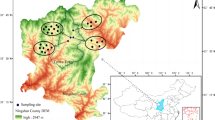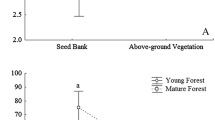Abstract
Emmenopterys henryi Oliv. (Rubiaceae) is an endangered tree species that is native to China. The wild populations of E. henryi have declined rapidly because of its poor natural regeneration, but the actual regeneration processes are not yet understood. In field tracking surveys and experiments in the Wuyishan Nature Reserve in Southeast China to determine the most important stage that affects the regeneration process, seed bank characteristics, seed germination, and seedling growth dynamics were studied in the typical habitats of E. henryi, Phyllostachys pubescens and broad-leaved forests. Results showed that in both P. pubescens and broad-leaved forests, more than 70% of the E. henryi seeds were distributed in moss and litter layers, and few were found in the soil beneath them. However, seed germination in the soil layer was significantly higher than in the moss and litter layers. Seed density, overall seed quality, and germination rate in the broad-leaved forest were significantly higher than in P. pubescens forest. Seed germination was highest in the microsites around the edge of the crown projection area of E. henryi mother trees. The order of survival rate of the seedlings on different ground surfaces was soil > moss > litter. In both habitats, the average seed density was 24.9 seeds m−2, and the total germination rate was less than 3.5‰. However, seedlings developed from only 1% of the germinated seeds, indicating that the seed germination is the most important stage in the natural regeneration of E. henryi.





Similar content being viewed by others

References
Argaw M, Teketay D, Olsson M (1999) Soil seed flora, germination and regeneration pattern of woody species in an acacia, woodland of the rift valley in ethiopia. J Arid Environ 43:411–435
Behtari B, De Luis M, Mohammadi Nasab AD (2014) Predicting germination of medicago sativa and onobrychis viciifolia seeds by using image analysis. Turk J Agric For 38:615–623
Bertacchi MIF, Amazonas NT, Brancalion PH, Brondani GE, Oliveira A, Pascoa MA, Rodrigues RR (2015) Establishment of tree seedlings in the understory of restoration plantations: natural regeneration and enrichment plantings. Restor Ecol 24:100–108
Chen L, Zhou K (2007) Study on the storage time of Emmenopterys henryi Oliv. seeds. J Huangshan Univ 9(5):64–66
Devagiri GM, Khaple AK, Mohan S, Venkateshamurthy P, Tomar S, Arunkumar AN, Joshi G (2016) Species diversity, regeneration and dominance as influenced by canopy gaps and their characteristics in tropical evergreen forests of Western Ghats, India. J For Res 27:799–810
Fang YP, Xiang J, Hu Y, Fu DA (2007) Present situation of Emmenopterys henryi resource protection in Dabieshan in Eastern Hubei. J Anhui Agric Sci 35(6):1756–1757
Guo LJ (2009) Population structure and dynamics of the rare plant Emmenopterys henryi. J Wuhan Bot Res 27(5):509–514
Guo LJ (2014) Spatial distribution pattern and number dynamics of Emmenopterys henryi seedlings endangered in China. Acta Bot Boreali Occident Sin 34(9):1887–1893
Guo LJ, Li M (2009) Fractal analysis of the distribution pattern of an endangered plant, Emmenopterys henryi population in Wuyi Mountain. Acta Bot Boreali Occident Sin 29(5):1033–1039
Guo LJ, Lin GW, Xu WH, Wang AP (2011) Characteristics of reproductive modules of Emmenopterys henryi natural population in Wuyi mountain. J Northwest For Univ 26(4):18–22
Guo LJ, Li M, Lin S (2015a) Flowering phenology, reproductive module characteristics and their influencing factors of an endangered plant Emmenopterys henryi. For Res 28(6):788–796
Guo LJ, Xue PP, Shao XH, Tian YQ, Xiao ZP (2015b) Growth characteristics and influencing factors of Emmenopterys henryi root sprouts. Plant Sci 33(2):165–175
Guo LJ, Xu WH, Fang HP, Xiao ZP, Tian YQ, Huang XH, Yin CM, Hu GX (2016) Seed rain, seed bank and natural regeneration of Emmenopterys henryi in different age class. Acta Bot Boreali Occident Sin 36(11):2273–2282
Hampe A, Arroyo J (2002) Recruitment and regeneration in populations of an endangered South Iberian Tertiary relict tree. Biol Conserv 107:263–271
Harper JL (1977) Population biology of plants. Academic Press, London, pp 33–150
Kanazashi A, Nagamitsu T, Suzuki W (2015) Seed dormancy and germination characteristics in relation to the regeneration of Acer pycnanthum, a vulnerable tree species in japan. J For Res 20:160–166
Kang HJ, Chen ZL, Liu P, Hao CY, Wei FM (2007) The population structure and distribution pattern of Emmenopterys henryi in Dapanshan Natural Reserve of Zhejiang Province. Acta Ecol Sin 27(1):0389–0396
Kang HJ, Liu P, Xu GD, Chen ZL, Wei FM (2008) Ecophysiological response of Emmenopterys henryi to the habitats in different altitudes in China’s Dapan mountain natural reserve. J Plant Ecol (Chinese Version) 32(4):865–872
Kang HJ, Chen ZL, Zhou YH, Quan W, Wu LH, Li QT (2011) Seed germination and dynamics of seedling growth of Emmenopterys henryi. J Cent South Univ For Technol 31(1):32–37
Lemke T, Janßen A, Porembski S (2015) Multiple limitations to the persistence of Trollius europaeus in a fragmented agricultural landscape in the context of metapopulation theory. Plant Ecol 216:319–330
Li ZY, Ban Q (1995) Biological characteristics and propagation method of Emmenopterys henyi. For Sci Tech 4:37–38
Li JM, Jin ZX (2004) Optimization of the RAPD conditions of Emmenopterys henryi and primary study on the genetic diversity. J Fujian For Sci Technol 31(2):36–40
Li G, Tan LH (2009) Progress on the conservation of biodiversity of coastal district. Chin Agric Sci Bull 25(12):260–262
Li TH, Zhou YX, Duan XP (2004) Physiological characteristics of the dormancy and light–sensitive germination of Emmenopterys henyi seeds. J Cent South For Coll 24(2):82–84
Li L, Zhang Y, Kong LN, Jiang HH, Chen JH, Zhou Y (2011) Soil physical characteristics and water storage capacity for six main forest lands in Wuyishan scenery district. Bull Soil Water Conserv 31(3):60–65
Liu YS (2008) Comparatively study on the characteristics of litter of different natural forests in Wuyishan scenery district. Master Thesis, Fujian Agriculture and Forestry University, Fuzhou, pp 38–45
Liu J, Deng X, Lü LX (2015) Relationship of tree growth and climatic factors at treeline of Picea likiangensis var. balfouriana forest in Basu County, Xizang. Chin J Plant Ecol 39(5):442–452
Ma ZW, He GF (1989) Studies on Chemical Chemical constituents of Emmenopterys henryi Oliv. native to China. Acta Bot Sin 31(8):620–625
Ma KP, Qian YQ, Wang C (1995) Present state and future of biodiversity studies. Sci Technol 13(1):27–30
Mayr E (1963) Animal species and evolution. Belknap Press of Harvard University Press, Cambridge, pp 127–131
McMinn JW (1992) Diversity of woody species 10 years after four harvesting treatments in the oak–pine type. Can J For Res 22:1179–1183
Molles MC (1999) Ecology: concepts and applications. Nucl Phys A 80:298–316
Salisbury EJ (1942) The reproductive capacity of plants. Studies in quantitative biology. G. Bell & Sons Ltd, London, pp 132–216
Schneider EE, Sánchez Meador AJ, Covington WW (2015) Reference conditions and historical changes in an unharvested ponderosa pine stand on sedimentary soil. Restor Ecol 24:212–221
Shi Z (2007) Study on the dynamic of soil respiration in different altitudes in Wuyi Mountain. Master Thesis, Nanjing Forestry University, Nanjing, pp 25–26
Silva MG, Tabarelli M (2001) Seed dispersal, plant recruitment and spatial distribution of Bactris acanthocarpa Martius (Arecaceae) in a remnant of Atlantic forest in Northeast Brazil. Acta Oecol 22:259–268
Singh O, Thapliyal M (2012) Variation in cone and seed characters in blue pine (Pinus wallichiana) across natural distribution in Western Himalayas. J For Res 23:235–239
Sra B, Lutz ER, Donath TW, Annette O (2011) Plant pattern development during early post–restoration succession in grasslands a case study of Arabis nemorensis. Restor Ecol 19:648–659
Sun SC, Chen LZ (2000) Seed demography of Quercus liaotungensis in Dongling mountain region. Acta Phytoecol Sin 24:215–221
Tang Y, Jin GZ, Zu YG (2002) Seed dispersal pattern and germination test of Rhodiola sachalinensis. J For Res 13:123–126
Taylor LAV, Hasenkopf EA, Cruzan MB (2015) Barriers to invasive infilling by Brachypodium sylvaticum in Pacific Northwest forests. Biol Invasions 17:2247–2260
Valtueña FJ, Ortega-Olivencia A, Rodríguez-Riaño T (2008) Germination and seed bank biology in some Iberian populations of Anagyris foetida L. (Leguminosae). Plant Syst Evol 275:231–243
Wang XL (2009) Application of Emmenopterys henryi to landscape design. Spec Econ Anim Plant 12(11):26–27
Wilcove DS, Master LL (2005) How many endangered species are there in the United States? Front Ecol Environ 3:414–420
Witkowski ETF, Garner RD (2000) Spatial distribution of soil seed banks of three African savanna woody species at two contrasting sites. Plant Ecol 149:91–106
Xu XY, Yao CH (2002) Studies on structure features of Emmenopterys henryi community in the Jiugongshan Nature Reserve. J Southwest For Coll 22(1):5–8
Xu WH, Wang AP, Zhang ZQ (2010) Fractal properties of spatial distribution of Emmenopterys henryi population in Wuyi Mountain by information dimension. J Zhejiang For Sci Technol 30(2):31–35
Yang KJ, Zhang XP, Zhang XW, Zhang ZX, Cao JJ (2007) Study on anatomical structure of leaves of rare plant Emmenopterys henryi Oliv. Bull Bot Res 27(2):195–198
Yang YF, Bai YP, Li JD, Li L (2010) Spatial patterns of seed dispersal in Hemiptelea davidii woodland in Keerqin sandy land, China. Chin J Appl Ecol 21(8):1967–1973
Zhang CS, Chen JH, Zhu F (2007) Survey and analysis on development law in Phyllostachys heterocycla cv. pubescens. Nonwood For Res 25(4):74–76
Zhou HB (2011) Study on chemical constituents and biological activities of Emmenopterys henryi. Master Thesis, The Second Military Medical University, Shanghai, pp 8–49
Zou CJ, Xu WD (1998) The Spatial—Temporal distribution of seed rain in Picea Mongolica Population. Chin J Ecol 17(3):16–19
Acknowledgements
We are grateful to Jiankui Zhan for helping in collecting seed data, Prof. Tang Jianwu for his valuable comments, and the Forestry Bureau of Wuyishan Nature Reserve for their help in logistics.
Author information
Authors and Affiliations
Corresponding author
Additional information
Project funding: This study was financially supported by the National Natural Science Foundation of China (NSFC) through Grant (Number 31360145).
The online version is available at http://www.springerlink.com
Corresponding Editor: Zhu Hong.
Rights and permissions
About this article
Cite this article
Guo, L., Xue, P., Li, M. et al. Seed bank and regeneration dynamics of Emmenopterys henryi population on the western side of Wuyi Mountain, South China. J. For. Res. 28, 943–952 (2017). https://doi.org/10.1007/s11676-017-0376-9
Received:
Accepted:
Published:
Issue Date:
DOI: https://doi.org/10.1007/s11676-017-0376-9



